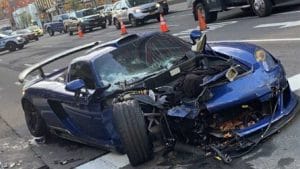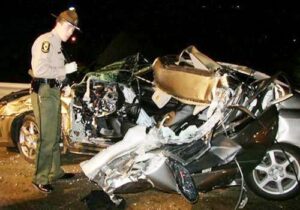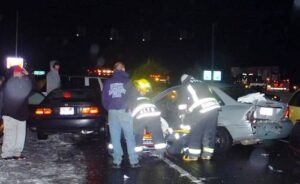
The lighter traffic volumes due to shelter-in-place orders have given some drivers a little too much courage.
(UPDATE: The National Safety Council now reports that, despite the sharp drop in traffic due to pandemic lockdowns, motor vehicle fatality rates jumped 14% in March, speeding, racing and other behaviors apparently behind the increase.)
More than three weeks after they disappeared, the bodies of a North Carolina couple were discovered inside a wrecked car “deep in the woods,” according to local police who estimated their vehicle had hit 103 mph at the time of the crash.
The incident that claimed the lives of Stephanie Mayorga and Paige Escalera was brutal, but far from unique, according to authorities. With traffic down as much as 80% in some parts of the country due to coronavirus lockdowns, there has been an epidemic of speeding, often at triple-digit rates. And while preliminary figures suggest there have been far fewer fender benders and conventional accidents during the past two months, the number of extreme, high-speed crashes appears to have skyrocketed.
“People (still) on the road have been getting the itch to drive faster,” said Susanna Gotsch, director of industry analysis for CCC Information Services, a firm that consults with insurance companies on auto crashes and repairs. As a result, she said, “There has been a pretty significant jump” in crashes resulting in “non-drivable” or “total loss” of vehicles.
(Smog down by as much as 30%, feds find, but traffic is on the rebound.)
The data is not yet available to confirm that this jump specifically is the result of motorists driving much faster during the pandemic, but “It points to higher speeds before impact,” Gotsch told TheDetroitBureau.com, noting that “total loss frequency is going up.”

There has been a 2% spike in crashes involving vehicles that can’t be driven from the scene, according to new data.
The numbers might not seem like much, at least at first blush. By mid-April, CCC saw a 2% increase in crashes involving vehicles that couldn’t be driven from the scene, often the case when high speeds are involved. In a normal year, even a 0.2% jump would raise eyebrows, said Gotsch. But the increase was all the more alarming when one considers that, on the whole, “there’s been a pretty significant drop in auto claims” since March, when most of the U.S. was ordered into lockdown.
It could take some time before experts have enough data to fully understand what has occurred. Among other things, they will be watching to see if there has been a jump in crashes involving pedestrians and bicyclists, both particularly vulnerable when motorists are speeding.
With fewer cars on the road, more motorists are able to travel at or above rated speeds. That’s particularly true in densely populated urban areas like Los Angeles which routinely has more than 80% of its freeways in “congested” conditions during rush hours, according to navigation service TomTom. In recent weeks, however, that seldom rises above 20% as millions of L.A. residents remain under shelter-in-place and work-from-home orders.
(Despite lockdowns, Americans still count on their cars to cope with pandemic.)
But even in rural communities, reports of speeding, especially at speeds approaching or exceeding 100 mph, have surged. Charlotte, North Carolina’s Spectrum News reported Monday that eight people have been killed in crashes on Mecklenburg County roads this year, up from two during the same period in 2019, with high-speeds involved in most of the incidents.

The rise in high-speed crashes isn’t just limited to the U.S. during the pandemic. Canada and Great Britain have seen an increase as well.
The situation isn’t unique to the U.S. British police have reported a similar explosion of speeding on the country’s limited-access roads. So has Canada, which also has had much of the country in lockdown since March. Last week, a teenager driving his father’s car was caught doing 191 mph on an Ontario roadway. More than 150 drivers have been charged with street racing or stunt driving in the province just since the beginning of May, according to the Ontario Provincial Police.
“In a ‘normal’ year, speeding-related crashes kill more than 10,000 people and cost society more than $52 billion,” Jennifer Homendy, a member of the National Transportation Safety Board, noted in a Washington Post op-ed this week.
How things will shake out this year remains to be determined and will likely be impacted by moves to bring the country out of lockdown. As more and more parts of the country return to something close to normal it could become more difficult to speed freely.
Meanwhile, authorities across the country have begun cracking down on what the Commercial Vehicle Safety Alliance has dubbed an “alarming trend of increased speeding on our roadways during the pandemic.” The trade group said this past week it will work with police to crack down on risky behavior by both commercial vehicles and regular motorists.
(Empty roads mean faster speeds.)
On the plus side, what CCC’s Gotsch said is a decline in more conventional crashes could pay off for American vehicle owners. Insurers have begun offering rebates, especially to those motorists impacted by lockdowns keeping them off the road. Allstate, one of the country’s biggest motor vehicle insurers, will return $600 million in premium, giving back to customers 15% of their April and May premiums. State Farm, the largest insurer, is paying back $2 billion in dividends to customers who will get 25% premium credits for the period between March 20 and May 31.
